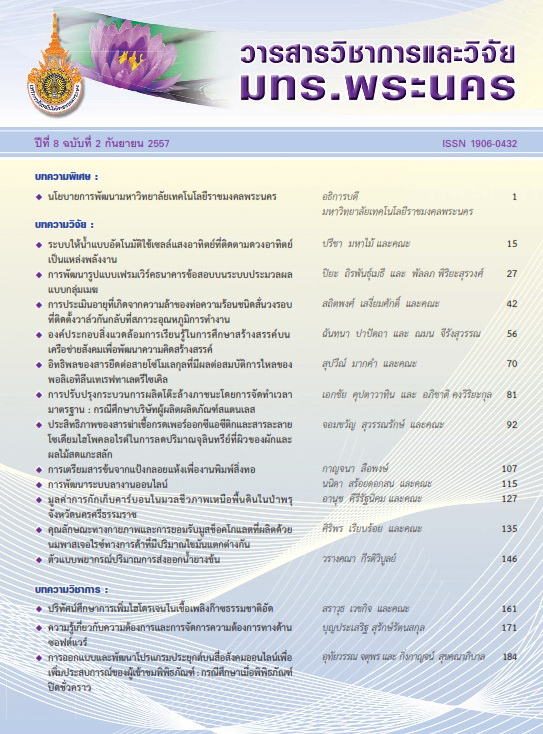การปรับปรุงกระบวนการผลิตโต๊ะล้างภาชนะโดยการจัดทำเวลามาตรฐาน กรณีศึกษาบริษัทผู้ผลิตผลิตภัณฑ์สแตนเลส
Main Article Content
Abstract
บทคัดย่อ
งานวิจัยนี้มีวัตถุประสงค์ เพื่อศึกษาและปรับปรุงกระบวนการผลิตโต๊ะล้างภาชนะ โดยจัดทำเวลามาตรฐาน กรณีศึกษาบริษัทผู้ผลิตผลิตภัณฑ์สแตนเลส เนื่องจาก ปัจจุบันบริษัทไม่ทราบกำลังการผลิตของผลิตภัณฑ์นี้ ทำให้ไม่สามารถควบคุมงานเพื่อกำหนดเวลาส่งงาน เกิดการส่งงานล้าช้าไม่ทันต่อความต้องการของลูกค้า การวิจัยนี้เริ่มต้นจาก การศึกษาผลิตภัณฑ์ เพื่อออกแบบแผนผังกระบวนการผลิต(OPC) การกำหนดสถานีปฏิบัติงาน หาเวลาการผลิตของแต่ละชิ้นส่วนเพื่อกำหนดเป็นเวลามาตรฐาน จัดทำแผนผังเวลาการผลิต(OPC TIME) และหาเวลามาตรฐานการผลิตรวมทั้งหมดของผลิตภัณฑ์ ผลการศึกษากระบวนการผลิตและจัดทำเวลามาตรฐาน พบว่า เวลาการผลิตของสถานีงานเชื่อมประกอบในการผลิต โครงโต๊ะ การผลิตอ่างซิงค์ก็อกหัวฉีดการผลิตอ่างซิงค์คอสูงปัดและการเชื่อมประกอบชิ้นส่วนทั้งหมดใช้เวลามากเป็นอันดับ 1 2 3 และ 4 ตามลำดับ คณะคณะผู้วิจัยได้เสนอแนะให้ปรับปรุงโดยเพิ่มเครื่องเชื่อม 2 เครื่อง และ คนงาน 2 คน ในสถานีงานเชื่อมประกอบ ซึ่งสามารถทำงานได้เร็วขึ้น ทำให้เวลาการผลิตรวมลดลงจากเดิม 855.24 นาที/ชุด เป็น 645.91 นาที/ชุดหรือเวลาลดลง24.47%
Abstract
The purposes of this research are to study and improve the productivity process of washing tables by setting standard time, a case study of stainless manufactories. Nowadays, the manufacturers don’t know the production capacity. That leads to the problems of manufacturers’ work control and late product delivery to the customers. The study is proposed to improve work procedures by designing operation process chart (OPC), the setting of operation stations, Operation process chart time (OPC TIME) and finding the standard time in product manufacture. As for the operation process and the standard time setting, the research revealed that the standard time of welding station in assembly process for the frame table, sink tap nozzle, high neck sink flick and welding station of all assembly parts were the first, the second, the third, and the fourth respectively. The researchers’ suggestions were to add 2 welding machines and 2 workers in assembly process so as to work more efficiently so that it can decrease the total processing time from 855.24 minutes/set to 645.91 minutes/set or 24.47 % reduction.


